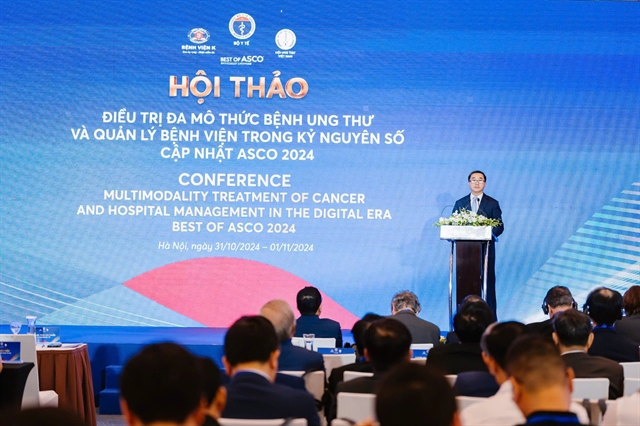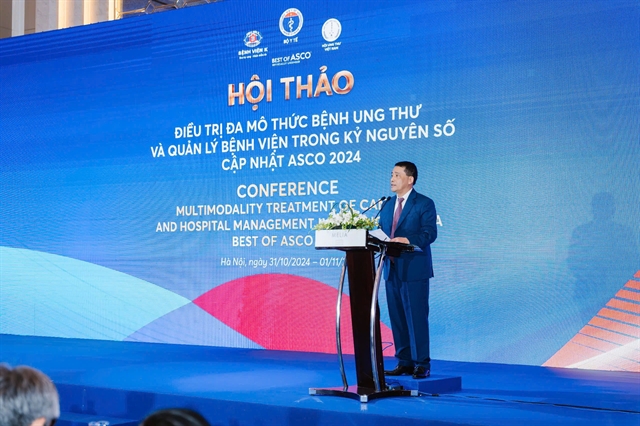 Society
Society


|
| Deputy Minister of Health Trần Văn Thuấn speaks at the event. — Photo courtesy of the K Hospital |
HÀ NỘI — Local and international health experts are discussing measures to improve the quality of cancer prevention and control in Việt Nam at an international conference on oncology in Hà Nội on October 31.
The two-day conference was jointly organised by K (Cancer) Hospital and the Việt Nam Cancer Association in collaboration with the American Society of Clinical Oncology.
With the theme 'Multimodal Treatment of Cancer and Hospital Management in the Digital Era – Best of ASCO 2024', the scientific forum hosted nearly 1,400 scientists and experts from Việt Nam and around the world.
Speaking at the event, Deputy Minister of Health Trần Văn Thuấn praised the Việt Nam Cancer Association and K Hospital for organising the meaningful conference to provide guidelines and strategies for cancer prevention as well as to create opportunities to learn, share and exchange experiences comprehensively in the field of cancer treatment.
“Cancer is becoming a major burden in many countries around the world, especially in low- and middle-income countries. It is predicted that by 2030, about 75 per cent of cancer deaths will occur in low- and middle-income countries.
"Furthermore, only 10 per cent of patients in low-income countries and 50-60 per cent in middle-income countries have access to radiotherapy, compared to 90 per cent in high-income countries. This highlights the inequality between high-income and low-middle-income countries, including Việt Nam,” said Thuấn.
“Cancer prevention requires modern, up-to-date professional knowledge and techniques from doctors and medical staff. I hope that the conference will bring many new ideas, making practical contributions to the development of oncology in particular and Vietnamese medicine in general,” added Thuấn.
At the event, participants heard that multimodality treatment is a combination of many methods to improve the effectiveness of cancer control. The three classic treatment methods (surgery, radiotherapy and chemotherapy) are increasingly proving their importance in cancer treatment.
The health sector of Việt Nam has recently earned many achievements in cancer prevention and treatment in the past years. The cure rate for some cancers at Hospital K and some other hospitals is on par with advanced countries in the region and the world. Another big advantage for cancer patients is that most tests, chemicals, radiotherapy and surgery are fully or partially covered by health insurance, although the costs are extremely expensive.
As the most recent health report showed, in 2023, payments for cancer treatment drugs will amount to more than VNĐ7.5 trillion, accounting for 15.8 per cent of total health insurance medical expenses, compared to more than VNĐ6.6 trillion (accounting for 14.5 per cent) in 2022.
Future trends in cancer treatment will continue to combine many methods: surgery, radiotherapy and systemic therapies, with an emphasis on personalised approaches for individual cases. There have been many advances in treatment recently, such as minimally invasive surgical techniques; cutting-edge radiotherapy technologies; targeted therapies and immunotherapies that have demonstrated curative potential for numerous patients, improved survival times and minimised adverse effects.

|
| Director of K Hospital Prof. Lê Văn Quảng speaks at the event. — Photo courtesy of the K Hospital |
Director of K Hospital Professor Lê Văn Quảng said that the increasing number of new cancer cases has led to an overload at many oncology hospitals in Việt Nam.
“The application of advanced treatment methods along with new medications requires high costs for treating cancer patients, which also puts some financial pressure on the health insurance system in Việt Nam. Aside from that, the current oncology workforce has not yet met the actual demand, requiring us to pay more attention to educational and training activities,” said Quảng.
The management of oncology hospitals needs to be discussed, with experiences shared by both domestic and international experts to improve the quality of cancer prevention and control in Việt Nam, according to Quảng.
During the conference's 16 sessions, domestic and international experts will discuss many topics, including advances in diagnosis and treatment, hospital management, management and use of health insurance funds, smart hospitals and radiation therapy in multimodal cancer treatment.
In particular, for the first time in Việt Nam, the conference will have thematic sessions on medical advances and the positive results of ASCO 2024 for both domestic and international experts.
The ASCO 2024 event will feature 30 presentations on diverse topics, including breast cancer, gynecological-urological cancers, lung cancer, head and neck cancers, digestive cancers and hematology.
It will also cover the application of new technologies, such as transoral surgery, photon-modulated radiotherapy in head and neck cancers, and the use of circulating tumour DNA in personalised colon cancer treatment. Additionally, findings on the correlation between biomarkers and treatment efficacy in breast cancer and risk factors for ovarian and endometrial cancers related to hormone replacement therapy will be highlighted.
The event provides a valuable opportunity for oncology doctors and researchers to exchange the latest updates and share high-value clinical practice experiences in an effort to contribute to the advancement of cancer diagnosis, treatment and patient care in Việt Nam.
According to GLOBOCAN 2022, there are over 19.9 million new cancer cases and 9.7 million cancer-related deaths globally each year. Việt Nam currently ranks 101st in terms of new cancer incidences and 42nd in mortality rate among 185 countries and territories. — VNS